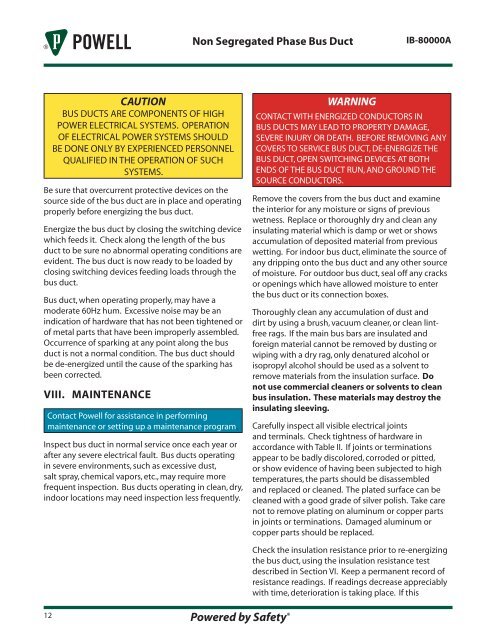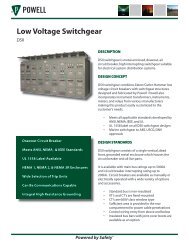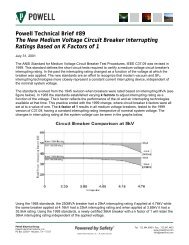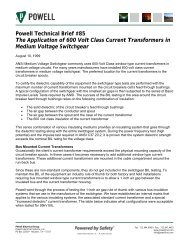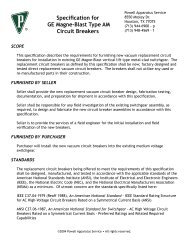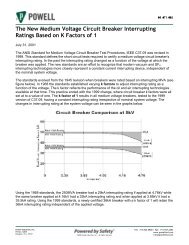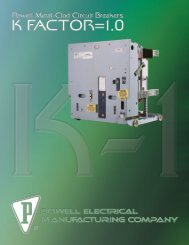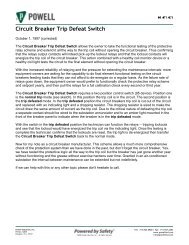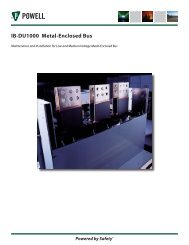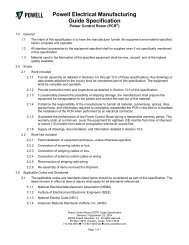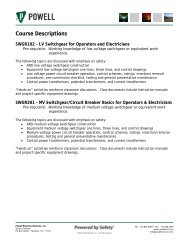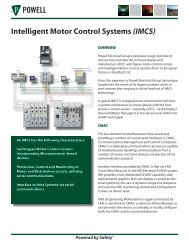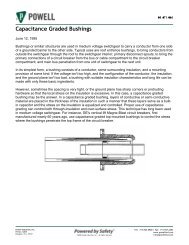IB-80000A Non Segregated Phase Bus Duct - Powell Industries, Inc.
IB-80000A Non Segregated Phase Bus Duct - Powell Industries, Inc.
IB-80000A Non Segregated Phase Bus Duct - Powell Industries, Inc.
You also want an ePaper? Increase the reach of your titles
YUMPU automatically turns print PDFs into web optimized ePapers that Google loves.
12 Powered by Safety ®<strong>Non</strong> <strong>Segregated</strong> <strong>Phase</strong> <strong>Bus</strong> <strong>Duct</strong> <strong>IB</strong>-<strong>80000A</strong>CAUTIONWARNINGBUS DUCTS ARE COMPONENTS OF HIGH CONTACT WITH ENERGIZED CONDUCTORS INPOWER ELECTRICAL SYSTEMS. OPERATION BUS DUCTS MAY LEAD TO PROPERTY DAMAGE,OF ELECTRICAL POWER SYSTEMS SHOULDBE DONE ONLY BY EXPERIENCED PERSONNELQUALIFIED IN THE OPERATION OF SUCHSYSTEMS.SEVERE INJURY OR DEATH. BEFORE REMOVING ANYCOVERS TO SERVICE BUS DUCT, DE-ENERGIZE THEBUS DUCT, OPEN SWITCHING DEVICES AT BOTHENDS OF THE BUS DUCT RUN, AND GROUND THESOURCE CONDUCTORS.Be sure that overcurrent protective devices on thesource side of the bus duct are in place and operatingproperly before energizing the bus duct.Remove the covers from the bus duct and examinethe interior for any moisture or signs of previouswetness. Replace or thoroughly dry and clean anyEnergize the bus duct by closing the switching devicewhich feeds it. Check along the length of the busduct to be sure no abnormal operating conditions areevident. The bus duct is now ready to be loaded byclosing switching devices feeding loads through thebus duct.<strong>Bus</strong> duct, when operating properly, may have amoderate 60Hz hum. Excessive noise may be anindication of hardware that has not been tightened orof metal parts that have been improperly assembled.Occurrence of sparking at any point along the busduct is not a normal condition. The bus duct shouldbe de-energized until the cause of the sparking hasbeen corrected.VIII. MAINTENANCEContact <strong>Powell</strong> for assistance in performingmaintenance or setting up a maintenance program.insulating material which is damp or wet or showsaccumulation of deposited material from previouswetting. For indoor bus duct, eliminate the source ofany dripping onto the bus duct and any other sourceof moisture. For outdoor bus duct, seal off any cracksor openings which have allowed moisture to enterthe bus duct or its connection boxes.Thoroughly clean any accumulation of dust anddirt by using a brush, vacuum cleaner, or clean lintfreerags. If the main bus bars are insulated andforeign material cannot be removed by dusting orwiping with a dry rag, only denatured alcohol orisopropyl alcohol should be used as a solvent toremove materials from the insulation surface. Donot use commercial cleaners or solvents to cleanbus insulation. These materials may destroy theinsulating sleeving.Carefully inspect all visible electrical jointsand terminals. Check tightness of hardware inInspect bus duct in normal service once each year or accordance with Table II. If joints or terminationsafter any severe electrical fault. <strong>Bus</strong> ducts operating appear to be badly discolored, corroded or pitted,in severe environments, such as excessive dust, or show evidence of having been subjected to highsalt spray, chemical vapors, etc., may require more temperatures, the parts should be disassembledfrequent inspection. <strong>Bus</strong> ducts operating in clean, dry, and replaced or cleaned. The plated surface can beindoor locations may need inspection less frequently. cleaned with a good grade of silver polish. Take carenot to remove plating on aluminum or copper partsin joints or terminations. Damaged aluminum orcopper parts should be replaced.Check the insulation resistance prior to re-energizingthe bus duct, using the insulation resistance testdescribed in Section VI. Keep a permanent record ofresistance readings. If readings decrease appreciablywith time, deterioration is taking place. If this


